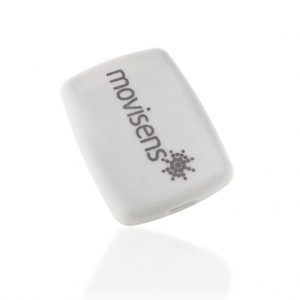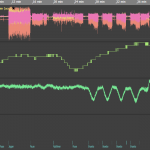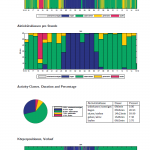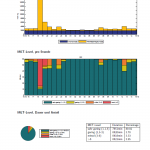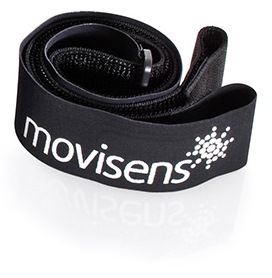Move II – Capteur d'Activité
movisens Move II est actuellement le capteur mobile le plus précis pour l'acquisition de l'activité physique - optimisé pour des fins de recherche.
Le capteur enregistre les données brutes d'accélération tridimensionnelle, de pression barométrique de l'air et de température jusqu'à 2 mois.
A partir de ces données, des paramètres comme le taux d'activité, la position du corps, les pas, la dépense énergétique et les équivalents métaboliques (Excel) peuvent être secondairement calculés à l'aide du logiciel DataAnalyzer de movisens, ainsi que des rapports significatifs (PDF).
Postulez gratuitement pour le projet d'étudiant
Principales caractéristiques
- Une reconnaissance précise et validée des activités quotidiennes
- Un calcul exact et validé de la dépense énergétique
- De meilleurs résultats grâce au capteur barométrique de l'altitude
- Des données durables grâce au format de fichier ouvert
- Un fonctionnement optimisé pour les études
Applications
- Monitorage comportemental
- Calcul de la dépense énergétique
- Reconnaissance de l'activité
- Détection du pas
- Acquisition des positions du corps
- Acquisition de l'inactivité, de la position assise et de la position debout
- L'activité physique en tant que paramètre contextuel
Produits et services adaptés
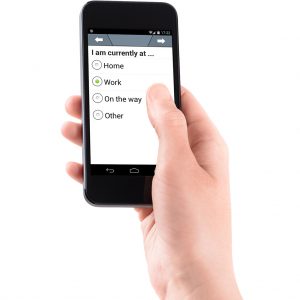
movisensXS
Echantillonnage de l'expérience plateforme
Solution d'échantillonnage de l'expérience basée sur un smartphone
Téléchargement
| Software |
|
|---|---|
| Documentation |
|
| Exemple de données |
|
| Exemple de rapports | |
| Outils externes |
Fiche technique
|
Power supply |
Lithium-Ion battery |
|
Supply voltage |
3 V |
|
Battery voltage |
2,7 - 4,2 V |
|
Number of charging cycles |
300 with 1C/1C > 80% |
|
Maximum recording capacity |
2 month |
|
Battery run time (recording) |
7 days |
|
Size of sensor (W x H x D) |
50 x 40 x 16 mm |
|
Weight of sensor |
16,1g |
|
Internal sensors |
3D acceleration sensor: Measurement range: +/- 8 g Noise: 4 mg Output rate: 64 Hz
Pressure sensor: Measurement range: 300 - 1100 hPa Noise: 0.03 hPa Output rate: 1 Hz |
|
Indicators |
LED, 3-color (operation and charging status) |
|
Interfaces |
Micro-USB |
|
Environmental conditions |
Temperature: -20 °C to 60 °C 0 °C to 45 °C during charging Humidity: 0 to 95% RH relative humidity Atmospheric pressure: 300 to 1100 hPa absolute |
Littérature et validations
- Actigraph-Measured Movement Correlates of Attention-Deficit/Hyperactivity Disorder (ADHD) Symptoms in Young People with Tuberous Sclerosis Complex (TSC) with and without Intellectual Disability and Autism Spectrum Disorder (ASD)..
- Accuracy of Sedentary Behavior–Triggered Ecological Momentary Assessment for Collecting Contextual Information: Development and Feasibility Study.
- Mood and dysfunctional cognitions constitute within-subject antecedents and consequences of exercise in eating disorders..
- OREBA: A Dataset for Objectively Recognizing Eating Behaviour and Associated Intake..
- Improving mobility and participation of older people with vertigo, dizziness and balance disorders in primary care using a care pathway: feasibility study and process evaluation.
- Fear of Physical Activity, Anxiety, and Depression. Barriers to Physical Activity in Outpatients With Heart Failure?.
- The Freiburg sport therapy program for eating disorders: a randomized controlled trial..
- Using Acceleration Data for Detecting Temporary Cognitive Overload in Health Care Exemplified Shown in a Pill Sorting Task.
- Sedentary behavior in everyday life relates negatively to mood: An Ambulatory Assessment study.
- Promotion of physical activity-related health competence in physical education: study protocol for the GEKOS cluster randomized controlled trial.
- Dynamics of Intraindividual Variability in Everyday Life Affect Across
Adulthood and Old Age. - Real-Time Detection of Spatial Disorientation in Persons with Mild Cognitive Impairment and Dementia.
- Neural correlates of individual differences in affective benefit of real-life urban green space exposure.
- Energy Expenditure During Incline Walking – Benefits of Integrating a Barometer into Activity Monitors.
- Individual Differences in the Competence for Physical-Activity-Related Affect Regulation Moderate the Activity–Affect Association in Real-Life Situations.
- Embodied learning in the classroom: Effects on primary school children's attention and foreign language vocabulary learning.
- Intermittent Fasting (Alternate Day Fasting) in Healthy, Non-obese Adults: Protocol for a Cohort Trial with an Embedded Randomized Controlled Pilot Trial.
- A novel algorithm for detecting human circadian rhythms using a thoracic temperature sensor Article history :.
- Physical Activity and Depressive Mood in the Daily Life of Older Adults.
- Measuring Fear of Physical Activity in Patients with Heart Failure.
- Lightweight Visual Data Analysis on Mobile Devices - Providing Self-Monitoring Feedback.
- Contributions à l’élaboration d’un système d’aide médico-sociale à l’aide d’un robot humanoïde.
- Situationsadaptive Navigationsassistenz für Menschen mit Demenz.
- Real-Time Management of Multimodal Streaming Data for Monitoring of Epileptic Patients.
- Bewegungsangst bei chronischer Herzinsuffizienz – Erste Ergebnisse zur Validierung eines Messinstruments..
- Fitness, kognitive Leistungsfähigkeit und Wohlbefinden bei jungen Erwachsenen - Interventionsstudien zum Einfluss von Ausdauertraining.
- Validation and comparison of two methods to assess human energy expenditure during free-living activities.
- Erfassung körperlicher Aktivität mittels Akzelerometrie - Möglichkeiten und Grenzen aus technischer Sicht.
- Home-based system for physical activity monitoring in patients with multiple sclerosis (Pilot study)..
- Detection of Parameters to Quantify Neurobehavioral Alteration in Multiple Sclerosis Based on Daily Life Physical Activity and Gait Using Ambulatory Assessment.
- Using Support Vector Regression for Assessing Human Energy Expenditure Using a Triaxial Accelerometer and a Barometer.
- A Comparison of Two Commercial Activity Monitors for Measuring Step Counts During Different Everyday Life Walking Activities.
- The Association between Short Periods of Everyday Life Activities and Affective States: A Replication Study Using Ambulatory Assessment.
- Characteristics of the activity-affect association in inactive people: an ambulatory assessment study in daily life.
- Acute and medium term effects of a 10-week running intervention on mood state in apprentices.
- Measurement of daily mobility under fampridine-therapy with Movisens-system in patients with multiple sclerosis.
- Assessment of Human Gait Speed and Energy Expenditure Using a Single Triaxial Accelerometer.
- Aktuelle Messverfahren zur objektiven Erfassung körperlicher Aktivitäten unter besonderer Berücksichtigung der Schrittzahlmessung.
- Kindergarten in Bewegung. Zur Qualität von Bewegungskindergärten..
- Assessment der Mobilität im Alltag zur Unterstützung von MS-Patienten.
- A new method to estimate energy expenditure using accelerometry and barometry-based energy models.
- Validity of the kmsMove-sensor in calculating energy expenditure during different walking intensities.
- Estimation of energy expenditure using accelerometers and activity-based energy models - validation of a new device.
- Trends und Möglichkeiten zur Erfassung körperlicher Aktivität im Alltag.
- Einsatz sensorgestützter Verfahren im Gesundheitswesen: Herausforderungen und Lösungsansätze.
- Bewegungskindergärten: empirische Befunde und praktisches Wissen.
- Energieumsatzmessung mit Aktivitätssensoren – Validität des kmsMove-Akzelerometers.
Vous trouverez plus de publications ici.
